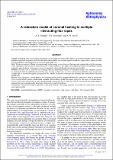Files in this item
A relaxation model of coronal heating in multiple interacting flux ropes
Item metadata
| dc.contributor.author | Hussain, A. S. | |
| dc.contributor.author | Browning, P. K. | |
| dc.contributor.author | Hood, A. W. | |
| dc.date.accessioned | 2017-01-09T11:30:24Z | |
| dc.date.available | 2017-01-09T11:30:24Z | |
| dc.date.issued | 2017-04 | |
| dc.identifier | 248665409 | |
| dc.identifier | e71addcc-24b3-471a-9bcb-f7a55d4c9ec5 | |
| dc.identifier | 85015732581 | |
| dc.identifier | 000400754000071 | |
| dc.identifier.citation | Hussain , A S , Browning , P K & Hood , A W 2017 , ' A relaxation model of coronal heating in multiple interacting flux ropes ' , Astronomy & Astrophysics , vol. 600 , A5 . https://doi.org/10.1051/0004-6361/201629589 | en |
| dc.identifier.issn | 0004-6361 | |
| dc.identifier.other | BibCode: 2017A&A...600A...5H | |
| dc.identifier.other | BibCode: 2017A&A...600A...5H | |
| dc.identifier.other | ORCID: /0000-0003-2620-2068/work/58055132 | |
| dc.identifier.uri | https://hdl.handle.net/10023/10070 | |
| dc.description | The authors wish to recognise funding from EPSRC through the Fusion Centre for Doctoral Training (Fusion-CDT - grant code: EP/K504178/1) through which this project is possible. Support from STFC for PKB and AWH is also acknowledged (grant numbers ST/L000768/1 and ST/N000609/1). | en |
| dc.description.abstract | Context: Heating the solar corona requires dissipation of stored magnetic energy, which may occur in twisted magnetic fields. Recently published numerical simulations show that the ideal kink instability in a twisted magnetic thread may trigger energy release in stable twisted neighbours, and demonstrate an avalanche of heating events. Aims: We aim to construct a Taylor relaxation model for the energy release from two flux ropes and compare this with the outcomes of the simulations. We then aim to extend the model to large numbers of flux ropes, allowing the possibility of modelling a heating avalanche, and calculation of the energy release for ensembles of twisted threads with varying twist profiles. Methods: The final state is calculated by assuming a helicity-conserving relaxation to a minimum energy state. Multiple scenarios are examined, which include kink-unstable flux ropes relaxing on their own, as well as stable and unstable flux ropes merging into a single rope as a result of magnetic reconnection. We consider alternative constraints that determine the spatial extent of the final relaxed state. Results: Good agreement is found between the relaxation model and the magnetohydrodynamic simulations, both for interactions of two twisted threads and for a multi-thread avalanche. The model can predict the energy release for flux ropes of varying degrees of twist, which relax individually or which merge through reconnection into a single flux rope. It is found that the energy output of merging flux ropes is dominated by the energy of the most strongly twisted rope. Conclusions: The relaxation approach provides a very good estimate of the energy release in an ensemble of twisted threads of which one is kink-unstable. | |
| dc.format.extent | 13 | |
| dc.format.extent | 630640 | |
| dc.language.iso | eng | |
| dc.relation.ispartof | Astronomy & Astrophysics | en |
| dc.subject | Magnetohydrodynamics (MHD) | en |
| dc.subject | Magnetic reconnection | en |
| dc.subject | Sun: corona | en |
| dc.subject | Sun: flares | en |
| dc.subject | Sun: magnetic fields | en |
| dc.subject | QB Astronomy | en |
| dc.subject | QC Physics | en |
| dc.subject | NDAS | en |
| dc.subject.lcc | QB | en |
| dc.subject.lcc | QC | en |
| dc.title | A relaxation model of coronal heating in multiple interacting flux ropes | en |
| dc.type | Journal article | en |
| dc.contributor.sponsor | Science & Technology Facilities Council | en |
| dc.contributor.sponsor | Science & Technology Facilities Council | en |
| dc.contributor.institution | University of St Andrews. Applied Mathematics | en |
| dc.identifier.doi | https://doi.org/10.1051/0004-6361/201629589 | |
| dc.description.status | Peer reviewed | en |
| dc.identifier.url | http://adsabs.harvard.edu/abs/2017A%26A...600A...5H | en |
| dc.identifier.grantnumber | ST/L005522/1 | en |
| dc.identifier.grantnumber | ST/N000609/1 | en |
This item appears in the following Collection(s)
Items in the St Andrews Research Repository are protected by copyright, with all rights reserved, unless otherwise indicated.

